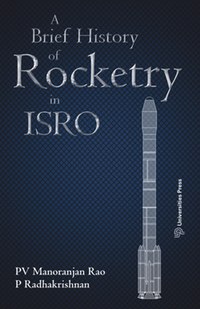Review: A Brief History of Rocketry in ISROby Jeff Foust
|
| It would be easy for a book like this to dive deep into technical details about Indian launch vehicles, but the authors also given plenty of attention to the people involved with those various launch programs. |
Authors PV Manoranjan Rao and P Radhakrishnan, retired officials with the Indian Space Research Organisation (ISRO), offer a broad, comprehensive history of India’s rocketry programs. Those efforts started with sounding rockets a half century ago and evolved into orbital launch vehicles, starting with the very small SLV-3 in the late 1970s (its first successful launch was in 1980), followed by the Augmented Satellite Launch Vehicle (ASLV) in the late 1980s and the two vehicles currently in use by ISRO, the Polar Satellite Launch Vehicle (PSLV) and the larger Geosynchronous Satellite Launch Vehicle (GSLV). The PSLV has become a “workhorse” for ISRO, in the words of its authors, launching a range of both Earth observing and science missions, including its Chandrayaan-1 lunar obiter; it will also be used for its planned Mars orbiter next year (see “India announces a mission to Mars”, The Space Review, August 20, 2012). The GSLV has not lived up to the same expectations, at least so far, although ISRO hopes the Mark III version of the rocket, with an indigenously-developed cryogenic upper stage, will help it take over launches of satellites that are currently handled by Ariane.
It would be easy for a book like this to dive deep into technical details about Indian launch vehicles, and the authors do devote a couple of chapters to specific topics like propulsion and avionics. However, they also given plenty of attention to the people involved with those various launch programs and the roles they played in both successful launches and overcoming failures. They single out several people, including Vikram Sarabhai, the father of India’s space program; and Satish Dhawan, a former chairman of ISRO who oversaw development of many key launch and satellite programs. (India’s spaceport at Sriharikota was named after Dhawan after his death in 2002.) Another familiar name frequently found in this book’s pages is APJ Abdul Kalam, who played leading roles in a number of early Indian rocketry programs and later served as president of India from 2002 to 2007.
This book is of niche interest, to be certain, primarily for those interested in India’s space program and/or the history of launch vehicle development in general. (Print editions of the book are primarily available only through Indian merchants, like this, although US readers may find it more convenient to get the ebook version via the Amazon link at the top of this review.) The book only briefly touches upon ISRO’s futre launch vehicle plans, including the GSLV Mark III and discussions about developing a reusable launch vehicle. An Indian RLV may be many years in the future, given the technological obstacles involved and the gradual pace of India’s launch efforts to date, but this book demonstrates that India has already overcome many hurdles towards becoming a spacefaring nation.
